| Author | Message | ||
| Jack Fids (Jack_fids)
Registered Member Username: Jack_fids Post Number: 35 Registered: 1-2009 Posted From: 32.176.156.181 Rating: N/A |
Thru the kindness & perseverance of a Gentleman from Houston I am the proud owner of a pair of like new & largely unused Trace 2512's, a commodity I have sought for some time, largely based on the cumulative knowledge of those who post here ...you ought to get a commission form them Ian! Now comes the decision that I'll have to live with, or around as the case may be, where to mount them. Before they arrived I envisioned using the rear bay on the drivers side where the old A/C compressor used to reside....HA! Nix on that! I figured that if was big enough to serve as a naughty/time out room for my wife that it would hold these 2 units EZ...no chance unless I stood them on end facing the top of that bay (roll-eyes here). So where did you mount yours or where have you seen them mounted that you thought was the better idea? The old condenser bay has been filled by Gen. Onan. I do have space above the battery drawer, against the rear/rear bulkhead but they would have to be mounted linearly ...in a line, which would obscure the readout panel on the back unit ...the proximity to the power source is a key consideration I am presuming, although I happen to be sitting on a large inventory of the heaviest of battery cable (#2 if memory serves me correct) Ya'll sold me on these Puppies... now where & what is the consensus on where to mount them....? BTW... the thrill of owning something that has the potential to take you off-grid for the rest of ones life is only exceeded by the security that comes with the unit & the quality of it, that realization is akin to winning a small lottery. | ||
| thomas flocks (Taflocks)
Registered Member Username: Taflocks Post Number: 239 Registered: 9-2009 Posted From: 74.76.246.165 Rating: N/A |
i have mine mounted with the generator in the 3rd bay back with a screened door. the first bay is under the drivers seat the second back holds all the house batteries, the third is the Honda propane generator and hart 1800 inverter but there is plenty of room for 2 inverters. | ||
| FAST FRED (Fast_fred)
Registered Member Username: Fast_fred Post Number: 1152 Registered: 10-2006 Posted From: 69.19.14.29 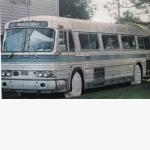 Rating: N/A |
Install it within 3 or 4 ft of the battery bank. And use the biggest cables (tinned wire with tinned terminal ends) and "military style " post clamps if the battery doesn't have flag terminals. Air circulation for the Trace is required as lots of amps go up in heat. FF | ||
| Jim Wilke (Jim Bob) (Pd41044039)
Registered Member Username: Pd41044039 Post Number: 469 Registered: 2-2001 Posted From: 184.0.3.170 Rating: N/A |
I agree 100 percent with Fred. You can push AC as far as you want with virtually no voltage drop. But not DC so you want the inverter/s to be as close to the batteries as possible without being in the same compartment (possible acid fume damage). And the farther you run the battery cables, the more chance for chafe or mechanical damage. Remember that although you may have a fuse at noe end, there is plenty of amperage at either end to start a fire. Now you just have to fit that advice into what is physically possible. | ||
| Sean Welsh (Sean)
Registered Member Username: Sean Post Number: 1080 Registered: 1-2003 Posted From: 72.171.0.148 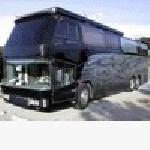 Rating: N/A |
Jack, 2 AWG is not nearly big enough for a 2512, even if you mount it right at the batteries. These units can draw over 400 amps at peak load, which requires a minimum of 000 and preferably 0000. At those amperages, voltage drop can be a killer, so I would not go more than, as suggested, three or four feet from the batteries, even with 0000. I am not familiar enough with your coach to make more concrete suggestions, but pay close attention to cooling. You can't mount them side-by-side without a large gap, otherwise the hot exhaust from one will be taken in the intake of the other, either causing it to trip or shortening its life, or both. If it comes down to having to mount them with the batteries, then you will need to use either gel or AGM batteries. Not only will the caustic humidity from flooded batteries damage the units, as has already been suggested, but worse is the possibility that a spark from one of the units could ignite hydrogen gas routinely vented by flooded batteries, causing an explosion. Lastly, I would not worry about being able to see the displays. You're going to want remote panels for these anyway, so you can control and monitor them from inside the coach. There is nothing available on the unit's display panel that is not also on the remote. -Sean http://OurOdyssey.BlogSpot.com | ||
| larry currier (Larryc)
Registered Member Username: Larryc Post Number: 327 Registered: 2-2007 Posted From: 207.200.116.13 Rating: N/A |
I had mine in the battery bay in my Eagle. They would shut down on a warm day from over temperature even with fresh air directed onto them. I used some good sized pieces of aluminum to mount them and put them on top of my water tanks. The aluminum pulls the heat out of them real well and the cool water keeps the bay temps down. The run is about 12 feet, they are much happier now than they were in the battery bay, they have yet to shut down, even on the warmest day. | ||
| Jack Fids (Jack_fids)
Registered Member Username: Jack_fids Post Number: 38 Registered: 1-2009 Posted From: 166.128.13.78 Rating: N/A |
Based on what you all have said, it looks like I'll be welding up a rack to mount the inverters above my enclosed house battery box drawer, the run of wire will be the shortest possible, the inverters will be off the floor, out of the way & best of all they won't be taking space that could be used for another purpose. I have a plethora of 12-volt fans to provide fresh air circulation that can be installed to ease any overheat issues. I would have mounted the inverters as close to the Genny IF you good people hadn't stepped up to the plate with your BETTER ideas.....THANKS! for keeping my feet out of that pothole. | ||
| thomas flocks (Taflocks)
Registered Member Username: Taflocks Post Number: 240 Registered: 9-2009 Posted From: 74.76.246.165 Rating: N/A |
my Genny is 6 inches away from the battery box so the inverter is on the other side of the batteries wall in with the Genny. i would agree about the fumes from the batteries being a problem. | ||
| FAST FRED (Fast_fred)
Registered Member Username: Fast_fred Post Number: 1160 Registered: 10-2006 Posted From: 71.43.14.193  Rating: N/A |
i would agree about the fumes from the batteries being a problem. Batt fumes are more of a theoretical than real problem. Best solution is a good acid proof tray to catch the spill over if they ever get boiled. There are even paints that claim to be OK with the acid . FF | ||
| Jack Fids (Jack_fids)
Registered Member Username: Jack_fids Post Number: 40 Registered: 1-2009 Posted From: 166.183.86.203 Rating: N/A |
Digging around in my piles of heavy flexible cable stock I found the 2 -40 ft. coils of #-2/0 & several lengths of SAE 4 & all of this inventory is 90Degree C rated. The SAE 4 seems to be twice the size the 2/0 , this doesn't jibe with the numbers as I understand them...any explanations? I'll be hunting for 0000 cable this week, about 12 ought to cover me. Can the 2/0 I have be used to feed the charger/inverter (Trace 2512) from the genny ( Onan 4500)?...the run is about 25 ft max. | ||
| Len Silva (Lsilva)
Registered Member Username: Lsilva Post Number: 356 Registered: 12-2000 Posted From: 72.187.35.208  Rating: N/A |
You can double or triple the 2/0 cable for added capacity. If it wont fit the connectors, you can "tap down" to a smaller cable for the last foot or so. | ||
| Sean Welsh (Sean)
Registered Member Username: Sean Post Number: 1081 Registered: 1-2003 Posted From: 67.142.130.22  Rating: N/A |
Jack, Not sure what you are asking in regards to "feeding" the 2512 from the genny. Unless you have a DC genny, this will be a 120VAC connection. IIRC, the 2512 can accept a maximum 60-amp feed, which would require only #4AWG. But since the max load you could have on the output 2512 is around 40 amps anyway, you can supply it with a 40-amp circuit and get by with #6, bearing in mind the tradeoff is less charge capacity while the loads are running. SAE and AWG are very different gauge standards. AWG is about 10% larger than SAE in any given value. SAE 4 should be just a tad smaller than 4AWG, which is waaay smaller than 2/0 (not to be confused with 2AWG). Are you sure you have 2/0, or do you have 2AWG? -Sean http://OurOdyssey.BlogSpot.com Sorry for all the edits -- my fingers apparently are not working today... (Message edited by Sean on April 26, 2010) | ||
| Len Silva (Lsilva)
Registered Member Username: Lsilva Post Number: 357 Registered: 12-2000 Posted From: 72.187.35.208  Rating: N/A |
Are you looking at the wire size or the exterior size? Some SAE cables have a very large insulation around them, but the wire size is quite small. I nearly got ripped off on some jumper cables that looked HUGE, but were really quite a small gauge. | ||
| David Evans (Dmd)
Registered Member Username: Dmd Post Number: 452 Registered: 10-2004 Posted From: 173.77.207.138 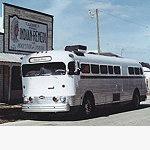 Rating: N/A |
Jack, you can probably download the owners manual and instalation instructions. They are pretty specific on how everything should be hooked up. I have an older Heart unit and was still able to get the info from www.xantrex.com website, and go to the library or support. Good luck | ||
| Tom Christman (Tchristman)
Registered Member Username: Tchristman Post Number: 215 Registered: 1-2006 Posted From: 66.218.33.156 Rating: N/A |
Think of an inverter as a stereo amplifier. Would you install it in the generator compartment? Install an inverter in a cool, dry spot-preferably inside to take advantage of the same air conditioning as you are using. Good Luck, TomC | ||
| Jack Fids (Jack_fids)
Registered Member Username: Jack_fids Post Number: 41 Registered: 1-2009 Posted From: 166.183.41.223 Rating: N/A |
I was headed that way before too long, thanks for the link & prompting it was the the most amount of helpful ! | ||
| George M. Todd (George_todd)
Registered Member Username: George_todd Post Number: 1002 Registered: 8-2006 Posted From: 99.29.76.171 Rating: N/A |
Jack, A little more information, which might change your placement thoughts. Electric resistance heat produces 3.41 BTU per watt. What this means is that your inverter will put out about 8500 BTU fully loaded, which is about 2/3 of the net output of an average roof air. Great to help keep you warm in the winter, not so cool in the summer... So, my suggestion is a dry well-ventilated compartment, where the inverter won't get wet or a lot of road dirt. FWIW, G | ||
| Don Evans (Doninwa)
Registered Member Username: Doninwa Post Number: 265 Registered: 1-2007 Posted From: 208.81.157.234 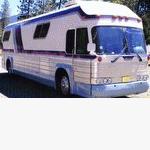 Rating: N/A |
George, If the inverter consumed all the input by putting it off as heat, there would not be any left for electrical output. I would suggest that the heat generated is closer to the percentage of inefficiency of the device. Still not something I would want in the living space. Don 4107 | ||
| Sean Welsh (Sean)
Registered Member Username: Sean Post Number: 1082 Registered: 1-2003 Posted From: 67.142.130.24  Rating: N/A |
George, I don't understand where you got 8,500 BTU/h. If Jack's pair of 2512s were fully loaded, they'd draw a total of 5,000 watts. At top load, these units are about 85% efficient, which would mean about 750 watts would be "lost" in the inverter, and it is this amount that would be dissipated as heat. 750 watts is only about 2,560 BTU/h, not 8,500 as you wrote. The other thing to remember is that inverter efficiency is actually much higher at lower loads, approaching 95% or so at around 10% of rated capacity. This is why it is almost always better to have a single large inverter than multiple smaller ones. And the actual capacity of the inverter goes down rapidly with rising temperature. At 77° you get 100% of the rated output, but at 104° you get only 80% and at 117° only 75%. At these higher temperatures, having the inverter in an air conditioned space may be the difference between being able to run an air conditioner, but give up a few BTU/h of cooling to the cause, or not run the A/C at all. For example, lets say you have a 4kW inverter and a pair of 15kBTU/h air conditioners that draw 1,800 watts each. You can easily run both units with the inverter at room temperature, and the inverter will be using up 1,843 BTU/h of your air conditioning, or just over 6% of your total cooling. In contrast, if the inverter is exposed to outside air and its temperature rises to 104° -- exactly when you might want all 30kBTU/h of capacity, your inverter capacity will drop to just 3,200 watts, and it will no longer be able to run both air conditioners (3,600 watts), forcing you to shut a whole unit down, a loss of 50% of cooling capacity. So depending on your objectives, mounting inverters where they can get the benefit of environmentally controlled air may be a better way to go. FWIW, YMMV, etc. etc. -Sean http://OurOdyssey.BlogSpot.com | ||
| George Martinez (Foohorse)
Registered Member Username: Foohorse Post Number: 107 Registered: 1-2010 Posted From: 174.48.6.180 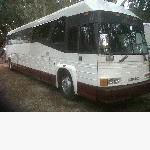 Rating: N/A |
Why waste this energy? is it not possible to mount these units inside a shroud with variable open/close flaps within the ducting? the forced fan air supplied to the inverters could come from within the coach and vent back into the cabin for cold weather use. in the summer the air could be supplied from either outside or cooled cabin air on really hot days, then exhausted back out. I am finding this thread very helpful. | ||
| George M. Todd (George_todd)
Registered Member Username: George_todd Post Number: 1003 Registered: 8-2006 Posted From: 99.29.76.171 Rating: N/A |
Sean, I may be off in my reasoning, but lets try this: At full load, the inverter produces 2500 Watts of 120 Volt AC, by consuming a little more than 2500 Watts of 12 Volt DC, agreed? The inverter is the controlling connection in the 12 Volt DC circuit, (it has essentially all the resistance) so Ohm's law applies. With no efficiency loss, the inverter would draw 208 Amps across a 12 Volt drop to produce 2496 Watts. Electric resistance heat produces 3.412 BTU per Watt, so 2496 X 3.412 is about 8500 BTU? Is there any difference between a 2500 Watt light bulb, and a 2500 Watt inverter as far as BTUs are concerned? I think we would also have to add the efficiency loss to that figure, but thats not the point. George | ||
| Sean Welsh (Sean)
Registered Member Username: Sean Post Number: 1083 Registered: 1-2003 Posted From: 67.142.130.41  Rating: N/A |
Sorry, George, that's not how it works. Let me give you a different example. Let's say you had an electric motor instead of an inverter, and that motor is used to move a loaded basket up a hoist cable. The amount of energy the motor consumes will be related to the weight of the basket and the height to which it is lifted. Sure, the motor will also produce heat, but that's because it is not 100% efficient. For sure, it does not produce as much heat as the amount of electricity it consumes. In this case, the motor is simply transforming one kind of energy (electrical) into another (potential). The energy has not "gone" anywhere, and it certainly has not been dissipated as heat. When the basket drops, it can turn the motor backwards, and most of the electricity used to hoist it can come right back out of the system. An inverter is not really any different. It is a device which converts one form of energy into another. In this case, DC power to AC power. The only reason it produces any heat at all in the process is because it is not 100% efficient. Only the inefficiency (difference between net input watts and net output watts) is dissipated as heat. The rest is passed on to the load. So, yes there is a huge difference between a 2500 watt light bulb and a 2500 watt inverter. A bulb dissipates every single watt as radiant energy, whereas the inverter passes 85%-95% of the watts on to the load. Now, if the load happens to also be a resistive device, then that device will, in turn, dissipate the energy as heat. But in the case where you are running motors, then, no -- much of the energy is transformed into mechanical energy, which can be used to perform work. For example, a motor could run a hydraulic pump to extend jacks to lift the coach -- none of that work ends up as heat. HTH, -Sean http://OurOdyssey.BlogSpot.com | ||
| R.C.Bishop (Chuckllb)
Registered Member Username: Chuckllb Post Number: 1245 Registered: 7-2006 Posted From: 75.243.33.181 Rating: N/A |
Good explanation, Sean...as usual. RCB | ||
| George Martinez (Foohorse)
Registered Member Username: Foohorse Post Number: 109 Registered: 1-2010 Posted From: 174.48.6.180  Rating: N/A |
I should have included this question in my post above, since I have yet reached a point of installing an inverter. is the complex shroud ducting set up I imagined worth the effort for the amount of heat produced by an inverter? | ||
| George M. Todd (George_todd)
Registered Member Username: George_todd Post Number: 1005 Registered: 8-2006 Posted From: 99.29.76.171 Rating: N/A |
Sean, I understand what you are saying, but there is more to it than that. First off, the oscillator circuit to get AC so it can be transformed has transistors made of silicon material, which has an inherent voltage drop thru it of 0.6 Volts. That has to come out as Wattage. Secondly, when the transistors are turning on and off, the resistance varies greatly, and any resistance in the DC part of the circuit is going to generate heat in the inverter. Now, all of the current going thru the transistors while they're fully biased, and thru the transformer isn't going to encounter much resistance, due to wire size, with which I agree. Next comes a comment from an air conditioning designer, after I asked a customer why he thought he needed a 3 Ton air conditioner in a "server room" with a large uninterruptible power supply in it. He said: "I don't know, that's what the engineer said he wanted." So, I called the engineer, and the answer I got back, which sure explained it all was: "Design for 10KW." Again, 3,412 BTU/Kilowatt, so 3 Tons at 12,000 BTU/Ton, is 36,000 BTU, which will cover the fully loaded UPS. As information to others, a UPS is just an inverter, batteries, and a charger, which runs computers in another room. Once you have inverted the 12 VDC into 12 VAC, there isn't much loss going thru the transformer and the filters, I agree, but the point is still resistive control of 12 VDC. An inverter doesn't change electrical energy into mechanical energy, and control its current flow by inductance, as a motor does. If the only heat produced by that inverter was because of inefficiency, it would produce about 125 Watts, or about 400+ BTU, which isn't much. HTH, George | ||
| George M. Todd (George_todd)
Registered Member Username: George_todd Post Number: 1006 Registered: 8-2006 Posted From: 99.29.76.171 Rating: N/A |
George, I don't think so, regardless of the fact that I think inverters put out more heat than Sean does. We also disagree AMICABLY! I also like the previous comment: "Because I said so doesn't cut it." You would have to make a plenum with two switchable inlets, and outlets, one each to inside and outside, to take advantage of some winter time heat, when the inverter was loaded, and keep it from offsetting some of your summertime AC. G | ||
| Sean Welsh (Sean)
Registered Member Username: Sean Post Number: 1084 Registered: 1-2003 Posted From: 67.142.130.20  Rating: |
Sorry, but no, there isn't. This is basic Thermodynamics 101.
George, absolutely everything you just wrote is correct -- but it is also ALL covered in the "efficiency" numbers for the entire unit. All the losses you wrote about are precisely why there is a 10-15% loss of efficiency in the inverter, which is what I already covered in my calculations above.
George, the engineer is not just cooling the UPS. He has to cool everything in the room. This is a closed system: the UPS and all the computers are in the same room. Every watt that goes in is ultimately dissipated as heat. But it is not all dissipated in the UPS -- in fact, MOST of it is dissipated in the loads. Remember, this is what I did for a living. What we were talking about above is different. If you put the inverter in one place, and the loads someplace else, you are not dissipating the heat at the inverter -- you are dissipating it at the loads.
Again, I don't see where your numbers come from. 15% of 5kW is 750 watts, not 125. That's what I used in my figures above. You don't need to believe me: you can prove this experimentally. Put the inverter in a box and measure the heat dissipation. It will exactly equal the input minus the output - no more, no less. BTW, I live with this every day on my bus, so I know exactly how much heat comes from my inverter. -Sean http://OurOdyssey.BlogSpot.com | ||
| George M. Todd (George_todd)
Registered Member Username: George_todd Post Number: 1007 Registered: 8-2006 Posted From: 64.55.111.6 Rating: N/A |
Sean, In your post of April 29, you mention "85-95% of the load is passed through. So, if we take 5% of 2500 Watts, that is 125 Watts, right? Thermodynamics 101 also says 3.41 BTU produced for every Watt of electricity consumed. So, 125 Watts consumed will produce 426 BTU. If we take 15% of 5000, that is indeed 750 Watts, which will produce about 2500 BTU of heat. Secondly, the 15 KW UPS is the standby, and pass thru power for a surgery suite, and is in its own room. The first HVAC contractor tried to cool it with a duct off the office thermostat, to no avail. Then he added an exhaust fan, which didn't work either. Then the general contractor came to me as the building engineer, to ask for help. (Obviously his sub isn't well-qualified.) The solution was a 5" tap off of the supply plenum at over 2" of static pressure, before any of the VAV boxes. I'm putting about 200 CFM of 58 degree air in an 8 X 8 room, and the UPS quit tripping. G | ||
| Sean Welsh (Sean)
Registered Member Username: Sean Post Number: 1085 Registered: 1-2003 Posted From: 67.142.130.40  Rating: N/A |
Sorry, George, should have been more clear. The inverter's efficiency is close to 95% at very low loads, so for a 2500 watt inverter, you might see that at, say, 100-200 watts. At higher loads, close to capacity, the efficiency is much less, closer to 85%. And since the OP has 5000 watts of inverters, I was using 15% of that figure as the worst-case heat load from the inverters themselves. -Sean http://OurOdyssey.BlogSpot.com |